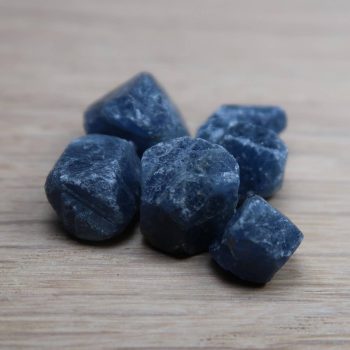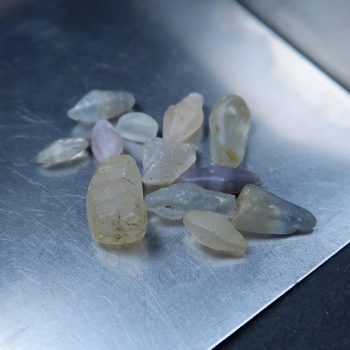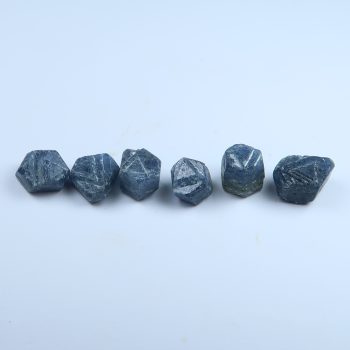Sapphire
Sapphires are one of the most well known precious stones on earth. Typically seen as a dark blue, they actually occur in many colours.
Sapphires can range from a few pounds to several thousand pounds per stone in price – higher grade pieces having better colour, or being more clear, of course.
Most of the best material will be cut into faceted stones for jewellery – almost every jeweller on the high street will have some Sapphire rings in the window.
Some is cut into cabochons, and the lower grade pieces are typically sold as specimens, both as Sapphire and as blue Corundum.
Showing all 3 results
-

Corundum Specimens / Rough (Blue/Sapphire)
£2.00 -

Corundum Specimens / Rough (Mixed)
£1.00 – £4.00 -

Corundum specimens with trigonal growth patterns
£2.95
Uses and History
Sapphire is often used as a decorative stone, as I’m sure you’re aware. They are usually faceted, but are also sometimes cut en cabochon, used in rings, earrings, pendants and – well, pretty much every other type of jewellery!
Due to their hardness, Sapphires are used for non decorative purposes too, with places in high end electronics, optics, watches, etc. These are, however, usually synthetic Sapphires rather than natural.
Locales
There are a great many Sapphire locales, especially around Asia. Sri Lanka is one of the best locales for Sapphire mining, producing 90% of all Star Sapphires.
Africa:
- Ambanja District, Diana Region (Northern Region), Antsiranana Province, Madagascar
- Zazafotsy, Ihosy, Ihorombe, Madagascar
- Mpwapwa District (Mpwampwa), Dodoma Region, Tanzania
- Uluguru Mts, Morogoro Region, Tanzania
- Umba Valley, Tanga Region, Tanzania
Asia:
- Area around Badakhshan, Afghanistan
- Kashiba City, Nara Prefecture, Japan
- Pyin-Oo-Lwin District, Mandalay Region, Myanmar
- Taplejung District, Province No. 1, Nepal
- Diamer District, Gilgit-Baltistan, Pakistan
- Hunza District, Gilgit-Baltistan, Pakistan
- Area around the Ilmen Mountains, Chelyabinsk Oblast, Russia
- Potanino, Leningrad Oblast, Russia
- Khibiny Massif, Murmansk Oblast, Russia
- Ratnapura District, Sabaragamuwa Province, Sri Lanka
Europe:
- Area around Centre-Val de Loire, France
- Laacher See Volcanic Complex, Glees, Germany
- Eifel Volcanic Fields, Germany
Australia and Oceania:
- Anakie, Central Highlands Region, Queensland, Australia
- Moorina, Blue Tier district, Dorset municipality, Tasmania, Australia
- Boat Harbour, Waratah-Wynyard municipality, Tasmania, Australia
- Poona, Cue Shire, Western Australia, Australia
- Amphitheatre, Pyrenees Shire, Victoria, Australia
North America:
- San Gabriel Mountains, San Bernardino Co., California, USA
- Little Belt Mountains, Judith Basin Co., Montana, USA
- Rock Creek Mining District, Granite Co., Montana, USA
- Helena Mining District, Lewis and Clark Co., Montana, USA
- Franklin Co., North Carolina, USA
- Cowee Valley, Macon Co., North Carolina, USA
- Franklin Mining District, Sussex County, New Jersey, USA
Mineralogy
When most people refer to Sapphire, they imagine a blue gemstone often used for jewellery.
However, the term ‘Sapphire’ actually refers to all gem grade varieties of Corundum, with the exception of red Corundum – Ruby.
Sapphires can occur in a range of colours, including black, blue, brown, colourless, green, multicoloured, orange, pink, purple, grey, white, or yellow. Some may even change colour in varying lights.
- Fancy Sapphire – a term given to various colours of Sapphire, including purple, violet, orange, green etc. The more common Sapphires (blue, yellow, pink) are often known purely by their colour.
- Padparadscha Sapphire – a rare pink-orange coloured gem with a distinct and unusual colour.
- Star Sapphire – a uniquely patterned material with asterism – a floating six rayed star, caused by the inclusion of small Rutile needles.
Hazards and Warnings
Unless powdered, there should be no health concerns with Sapphire or Corundum. Aluminium Oxide can be a fire/toxic hazard, but this should not be an issue with the crystalline form.
Almost all rocks, minerals (and, frankly, almost all other substances on earth) can produce toxic dust when cutting, which can cause serious respiratory conditions including silicosis.
When cutting or polishing rocks, minerals, shells, etc, all work should be done wet to minimise the dust, and a suitable respirator or extraction system should be used.
Translations
Arabic:
- ياقوت أزرق
Hindi:
- नीलम
Portuguese:
- safira
Bengali:
- নীলকান্তমণি
Indonesian:
- safir
Punjabi:
- ਨੀਲਮ
English:
- sapphire
- blue corundum
Italian:
- zaffiro
Russian:
- сапфир
French:
- saphir
Japanese:
- サファイア
Spanish:
- zafiro
German:
- saphir
Korean:
- 사파이어
Thai:
- ไพลิน
Gujurati:
- નીલમ
Mandarin and Traditional Chinese:
- 蓝宝石
- 藍寶石
Urdu:
- نیلم
